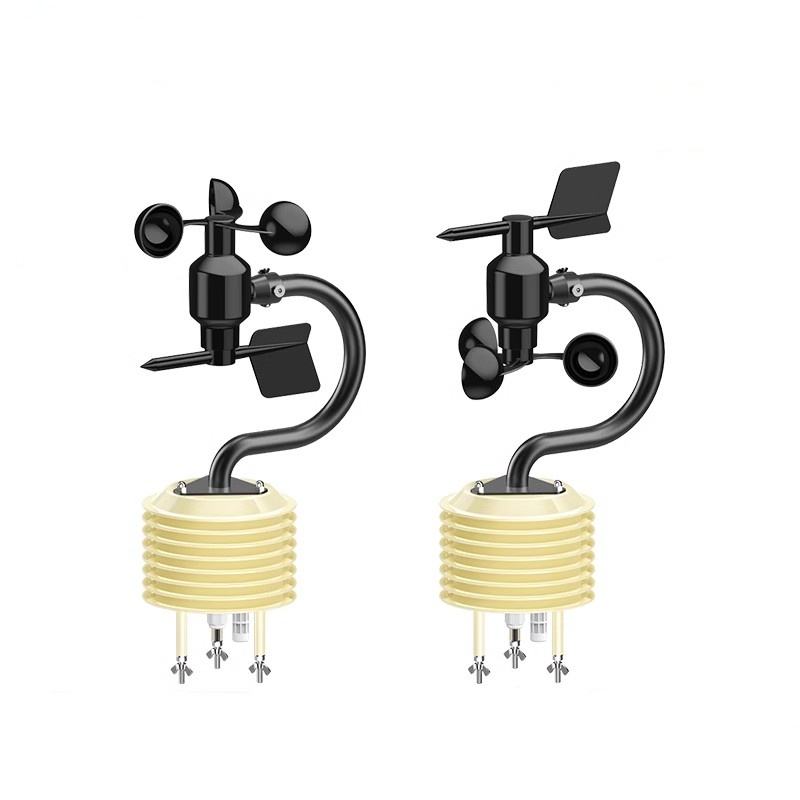Meteoroloji stansiyalar kənd təsərrüfatı istehsalında mühüm rol oynayır, xüsusilə iqlim dəyişikliyinin artması şəraitində, aqrometeoroloji xidmətlər dəqiq meteoroloji məlumatlar və proqnozlar təqdim etməklə fermerlərə kənd təsərrüfatı məhsullarını optimallaşdırmağa və məhsul məhsuldarlığını və keyfiyyətini yaxşılaşdırmağa kömək edir. Aşağıda meteoroloji stansiyalar və aqrometeoroloji xidmətlər arasında əlaqələrin ətraflı təhlili verilmişdir:
1. Meteoroloji stansiyaların əsas funksiyaları
Hava stansiyaları ətraf mühitin iqlim elementlərini real vaxt rejimində izləmək üçün müxtəlif sensorlar və avadanlıqlarla təchiz olunub, o cümlədən:
Temperatur: toxumun cücərməsinə, bitkilərin böyüməsinə və yetişməsinə təsir göstərir.
Rütubət: Suyun buxarlanmasına və bitkilərin xəstəliklərin inkişafına təsir göstərir.
Yağış: Torpağın nəmliyinə və suvarma ehtiyaclarına birbaşa təsir göstərir.
Küləyin sürəti və istiqaməti: Məhsulun tozlanmasına və zərərvericilərin və xəstəliklərin yayılmasına təsir göstərir.
İşıq intensivliyi: fotosintez və bitki böyümə sürətinə təsir göstərir.
Məlumatlar toplandıqdan sonra, hava dəyişikliklərini təhlil etmək və proqnozlaşdırmaq və kənd təsərrüfatı ilə bağlı qərarlar üçün əsas yaratmaq üçün istifadə edilə bilər.
2. Aqrometeoroloji xidmətlərin vəzifələri
Aqrometeoroloji xidmətin əsas məqsədi elmi meteoroloji məlumat dəstəyi vasitəsilə kənd təsərrüfatı istehsalının səmərəliliyini və fermerlərin iqtisadi faydalarını artırmaqdır. Xüsusilə, aqrometeoroloji xidmətlər aşağıdakı sahələrə diqqət yetirir:
Dəqiq gübrələmə və suvarma: Meteoroloji məlumatlara əsaslanaraq, resursların lazımsız israfının qarşısını almaq üçün gübrələmə və suvarma vaxtının ağlabatan təşkili.
Məhsulun böyümə dövrünün proqnozu: Meteoroloji məlumatlardan istifadə edərək məhsulun böyümə mərhələsini proqnozlaşdırmaq, fermerlərə əkin və məhsul yığmaq üçün düzgün vaxtı seçməkdə kömək etmək.
Xəstəlik və zərərvericilərə qarşı xəbərdarlıq: Temperaturun, rütubətin və digər göstəricilərin monitorinqi ilə məhsulun xəstəlikləri və zərərvericiləri riskinin vaxtında proqnozlaşdırılması və erkən xəbərdar edilməsi, fermerləri müvafiq profilaktika və mübarizə tədbirlərinin görülməsinə istiqamətləndirmək.
Təbii fəlakətlərə cavab tədbirləri: Fermerlərə fövqəladə planlar hazırlamağa və itkiləri azaltmağa kömək etmək üçün daşqınlar, quraqlıqlar və şaxtalar kimi təbii fəlakətlər barədə erkən xəbərdarlıq edin.
3. Dəqiq kənd təsərrüfatının həyata keçirilməsi
Texnologiyanın inkişafı ilə meteoroloji stansiyaların tətbiqi də daim təkmilləşdirilir və bir çox kənd təsərrüfatı istehsalı dəqiq kənd təsərrüfatı anlayışını birləşdirməyə başlamışdır. Dəqiq hava monitorinqi vasitəsilə fermerlər:
Yerində monitorinq: Portativ meteoroloji stansiyalar və dronlar kimi texnologiyalardan istifadə etməklə, müxtəlif sahələrdə hava dəyişikliklərinin real vaxt rejimində monitorinqi fərdiləşdirilmiş idarəetmə strategiyalarına nail ola bilər.
Məlumat mübadiləsi və təhlili: Bulud hesablamalarının və böyük verilənlər texnologiyasının yüksəlişi ilə meteoroloji məlumatlar hərtərəfli təhlil formalaşdırmaq və kənd təsərrüfatı ilə bağlı qərarların qəbulu üçün daha əhatəli məlumat dəstəyi təmin etmək üçün digər kənd təsərrüfatı məlumatları (torpağın keyfiyyəti və məhsul artımı kimi) ilə birləşdirilə bilər.
Ağıllı qərar dəstəyi: Fermerlərə istehsal qərarlarını optimallaşdırmağa kömək etmək üçün tarixi hava məlumatları və real vaxt monitorinq məlumatı əsasında idarəetmə tövsiyələrini avtomatik yaratmaq üçün maşın öyrənməsi və süni intellektdən istifadə edin.
4. Keys tədqiqatları və tətbiq nümunələri
Bir çox ölkələrin aqrometeoroloji xidmətləri meteoroloji stansiyaların elmi tətbiqini uğurla həyata keçirib. Budur bir neçə uğurlu hal:
Milli Aqrometeoroloji Şəbəkə (NCDC) fermerlərə real vaxt rejimində hava məlumatları və aqrometeoroloji xidmətlər təqdim edən milli meteoroloji stansiyalar şəbəkəsi vasitəsilə məhsullarını idarə etməyə kömək edir.
Çinin Aqrometeoroloji Xidmətləri: Çin Meteorologiya İdarəsi (CMA) bütün səviyyələrdə meteoroloji stansiyalar vasitəsilə, xüsusən də düyü tarlaları və meyvə bağları kimi xüsusi məhsul mədəniyyətlərində müntəzəm meteoroloji hesabatlar və fəlakət xəbərdarlığı ilə aqrometeoroloji xidmətlər həyata keçirir.
Hindistanın AqroMeteorologiya Mərkəzi (IMD): Meteoroloji stansiyalar şəbəkəsi vasitəsilə IMD fermerlərə kiçik təsərrüfatların məhsuldarlığını və davamlılığını yaxşılaşdırmaq üçün optimal əkin, gübrələmə və məhsul yığım vaxtları daxil olmaqla əkin məsləhətləri verir.
5. Davamlı inkişaf və problem
Meteoroloji stansiyaların aqrometeoroloji xidmətlərdə mühüm rol oynamasına baxmayaraq, hələ də bəzi problemlər mövcuddur:
Məlumatların toplanması və təhlili imkanları: Bəzi ərazilərdə meteoroloji məlumatların əldə edilməsinin etibarlılığı və vaxtında olması hələ də kifayət deyil.
Fermer qəbulu: Bəzi fermerlərin yeni texnologiyalardan anlayışı və qəbulu aşağı səviyyədədir, bu da meteoroloji xidmətlərin praktiki tətbiqinə təsir göstərir.
Meteoroloji dəyişikliyin gözlənilməzliyi: İqlim dəyişikliyinin yaratdığı ekstremal hava kənd təsərrüfatı məhsullarını daha qeyri-müəyyən edir və meteoroloji xidmətlərə daha yüksək tələblər qoyur.
nəticə
Bütövlükdə, meteoroloji stansiyalar aqrometeoroloji xidmətlərdə mühüm strateji rol oynayır, dəqiq məlumatlar və effektiv qərar dəstəyi təmin etməklə kənd təsərrüfatı istehsalının davamlı inkişafına töhfə verir. Texnologiyada irəliləyişlər və təkmilləşdirilmiş məlumatların təhlili imkanları ilə meteoroloji stansiyalar kənd təsərrüfatının inkişafı üçün möhkəm zəmin yaratmağa davam edəcək, fermerlərə dəyişən iqlim şəraitinə uyğunlaşmağa və sənayenin rəqabət qabiliyyətini və dayanıqlığını artırmağa kömək edəcək.
Daha çox meteoroloji stansiya məlumatı üçün,
zəhmət olmasa Honde Technology Co., LTD ilə əlaqə saxlayın.
Email: info@hondetech.com
Şirkət veb saytı:www.hondetechco.com
Göndərmə vaxtı: 27 dekabr 2024-cü il


